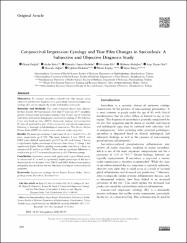Conjunctival impression cytology and tear film changes in sarcoidosis: A subjective and objective diagnosis study

View/
Access
info:eu-repo/semantics/openAccessDate
2023Author
Eroğul, ÖzgürBalcı, Aydın
Gobeka, Hamidu Hamisi
Efe, Neriman
Akdoğan, Müberra
Oral, Ayşe Yeşim
Doğan, Mustafa
Özdemir, Çiğdem
Kaşıkçı, Murat
Saraçlı, Sinan
Metadata
Show full item recordCitation
Eroğul, Ö., Balcı, A., Gobeka, H. H., Efe, N., Akdoğan, M., Oral, A. Y., ... & Saraçlı, S. (2023). Conjunctival Impression Cytology and Tear Film Changes in Sarcoidosis: A Subjective and Objective Diagnosis Study. Turkish journal of ophthalmology, 53(4), 200-205.Abstract
Objectives:
To evaluate sarcoidosis-induced tear film changes using subjective and objective diagnostic tests, particularly conjunctival impression cytology (IC), and to compare the results with healthy individuals.
Materials and Methods:
This study evaluated clinical data collected between January 2019 and January 2021 from 57 right eyes of 57 sarcoidosis patients without ocular involvement (Group 1) and 33 right eyes of 33 healthy individuals with similar demographic characteristics (Group 2). The Schirmer I test, tear break-up time (TBUT), fluorescein staining, and conjunctival IC were all performed as part of the conjunctival and corneal examinations following a thorough ophthalmological examination. The Ocular Surface Disease Index (OSDI) was used to assess subjective ocular symptoms.
Results:
The mean ages in Groups 1 and 2 were 49.26±3.18 and 51.91±2.89 years, respectively (p=0.720). The mean Schirmer I test, TBUT, and OSDI scores differed significantly (p<0.05 for all), with Group 1 having a significantly higher percentage of dry eyes than Group 2. Group 1 had significantly higher Nelson’s grading system grades than Group 2 based on conjunctival IC analysis (p=0.001). There were no significant differences in visual acuity (p=0.17) or intraocular pressure (p=0.14) between groups.
Conclusion:
Sarcoidosis patients had significantly higher Nelson grades in conjunctival IC, as well as significantly higher percentages of dry eye as determined by the Schirmer I test, TBUT, and OSDI. Reduced tear quantity and quality may destabilize the tear film layer, resulting in a variety of ocular symptoms.
Source
Turkish journal of ophthalmologyVolume
53Issue
4URI
https://dx.doi.org/10.4274/tjo.galenos.2022.58153.2149-8709
https://hdl.handle.net/20.500.12933/1584















